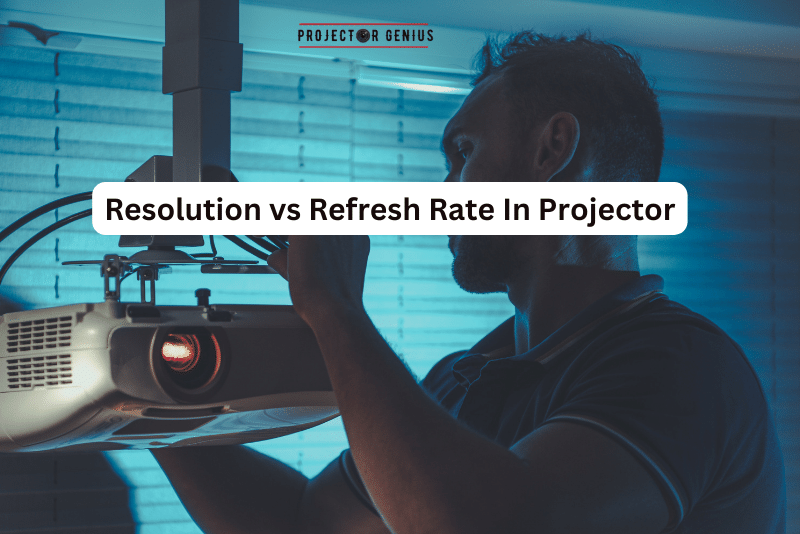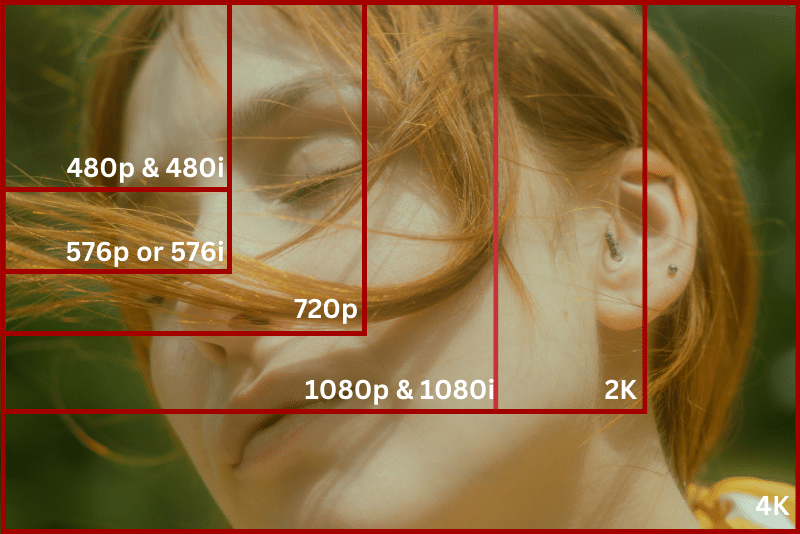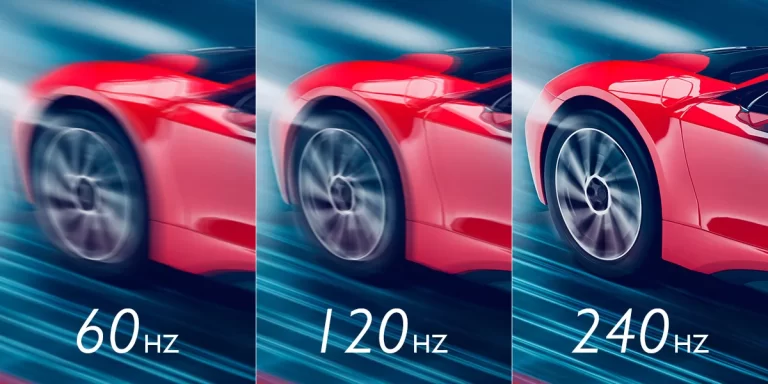Resolution vs Refresh Rate In Projector [2023 Complete Guide]
-
 Written by:
Kristy Roger
Written by:
Kristy Roger
- Last Updated:
When you watch a movie on a projector, two things help make the picture look great: “Resolution” and “Refresh Rate.” Think of resolution like the sharpness of the picture.
Now, imagine flipping through a picture book really fast. That’s kind of like the refresh rate – it’s how quickly the projector changes the pictures to make a movie. These might sound like big words, but don’t worry!
In this guide, we’ll explain them in a simple way, so you’ll know what makes your movies look so smooth and clear. Let’s dive in!
Resolution vs Refresh Rate In Projector? Resolution in projectors determines image clarity, while refresh rate influences the smoothness of motion. A balance between the two is crucial for an optimal viewing experience.

I recommend using the Table of Contents to quickly access the information you need.
My article is designed to cater to home cinema users of all levels, from Beginners to Advanced enthusiasts.
Table of Contents
What is Resolution?
Resolution in a projector refers to the level of detail and clarity that the device can display. It’s like the sharpness of a photograph or the clarity of a TV screen. The resolution is usually described in terms of pixels, which are tiny dots that make up the image. The higher the resolution, the more pixels there are, and thus, the clearer and crisper the image appears.
For example, a projector with a resolution of 1920×1080 means it can display 1920 pixels horizontally and 1080 pixels vertically. This is often referred to as “Full HD” resolution.
If you’re watching a movie or giving a presentation, a higher resolution projector will give you a more detailed and lifelike image, allowing your audience to see every detail with precision.
Keep in mind that the right resolution for you depends on what you’ll be using the projector for, and the size of the screen you plan to project onto.

What is Refresh Rate?
The refresh rate in a projector is the number of times per second that the image on the screen is redrawn. It’s a crucial factor, especially in fast-moving scenes or videos. A higher refresh rate means smoother motion and less blurriness. Think of it like a flipbook – the more pages you have, the smoother the animation appears.
For example, a projector with a 60Hz refresh rate updates the image 60 times per second. This is standard for many projectors and works well for most applications. However, if you’re into fast-paced action like gaming or sports, a higher refresh rate, such as 120Hz or even 240Hz, can make a noticeable difference in the clarity of motion.
Keep in mind, though, that the effectiveness of a higher refresh rate depends on the content you’re displaying and the capabilities of your source device. So, when choosing a projector, it’s important to consider not just the refresh rate, but also the type of content you’ll be projecting.
Resolution vs Refresh Rate: Compare Impact of Resolution and Refresh Rate
When it comes to projectors, resolution and refresh rate are like two sides of a coin, each bringing its own set of advantages. Resolution, for starters, dictates the level of detail you’ll see on the screen. It’s like the fine brushstrokes on a painting – the higher the resolution, the more nuanced and clear the image becomes.
This matters especially for intricate visuals or text-heavy presentations. A 1080p projector, for instance, renders images with impressive sharpness and clarity.
On the flip side, refresh rate is all about motion, the smoothness of action on the screen. It’s akin to a dance with a steady rhythm – the higher the refresh rate, the smoother the motion appears. This is a game-changer for action-packed scenes or dynamic presentations. A projector with a 120Hz refresh rate, for instance, ensures that every movement flows seamlessly, leaving no room for blurs or stutters.
Now, let’s talk balance. Choosing between resolution and refresh rate is like picking the right tool for the job. If your focus leans towards static images, resolution steals the show, painting each detail with precision.
On the other hand, if your content thrives on motion, a higher refresh rate brings it to life, capturing every dynamic moment. Striking the right balance depends on your specific needs and preferences. That said, ideally, a projector with a blend of decent resolution and a smooth refresh rate offers a versatile visual experience that caters to a wide array of content.
So, whether you’re delving into fine details or reveling in action-packed sequences, finding the sweet spot between resolution and refresh rate ensures a visual treat that hits all the right notes.
How do Different Display Devices (monitors, TVs, laptops) Handle Resolutions and Refresh Rates?
Let’s dive into how various display devices handle resolutions and refresh rates. Each device brings its own flavor to the table, shaping the visual experience in distinct ways.
Monitors, for instance, are known for their precision. They excel at handling a wide range of resolutions, offering sharp and detailed visuals. From basic HD to jaw-dropping 4K, monitors adapt seamlessly, ensuring that every pixel is presented with utmost clarity.
When it comes to refresh rates, gaming monitors take the lead. They boast higher refresh rates, often up to 240Hz, which means smoother motion for fast-paced action.
On the other hand, TVs are built for immersive experiences. They tend to have a standard resolution, often 1080p or 4K, optimized for viewing from a distance. The focus here is on vibrant colors and deep contrast, making them ideal for movies, shows, and gaming.
While TVs generally have lower refresh rates compared to gaming monitors, the emphasis lies in delivering cinematic visuals, where fluid motion may not be as critical.
Laptops, being versatile creatures, strike a balance. They come in various sizes and resolutions, catering to different user preferences. From compact screens with HD resolutions to larger displays boasting 4K, laptops aim to be all-rounders.
The refresh rates on laptops tend to be standard, ensuring smooth everyday tasks, though gaming laptops often up the ante with higher rates to accommodate dynamic gameplay.
Ultimately, it’s about finding the right tool for the task. Monitors are the precision artists, perfect for detailed work. TVs offer cinematic experiences, ideal for relaxed viewing. Laptops, in their adaptability, bridge the gap.
Each device complements a particular use case, ensuring that whether you’re editing images, binge-watching your favorite series, or engaging in intense gaming sessions, the display device delivers an experience tailored to your needs.
Pros and Cons of High Resolution and High Refresh Rate
Here’s an honest rundown of the pros and cons of both high resolution and high refresh rate:
When it comes to high resolution, the perks are crystal clear. Firstly, it’s all about the finer details. High resolution means more pixels, which translates to sharper images and text. This is a game-changer for tasks like photo editing or graphic design, where precision is key. Additionally, a high-res display is a visual feast for watching movies or playing games with intricate graphics. It pulls you into a world of stunning clarity and depth.
However, there’s a trade-off. Higher resolution can be demanding on your system resources. It might require a beefier graphics card to keep up, which can add to the overall cost. Also, if your content isn’t optimized for high resolution, you might not notice a significant difference. It’s like having a powerful engine in a city with a low speed limit – you won’t get to fully utilize its potential.
Now, let’s shift gears to a high refresh rate. This is all about smoothness and fluidity in motion. A higher refresh rate, like 144Hz or 240Hz, means less motion blur, which is a game-changer for gamers and fans of action-packed movies. It’s like upgrading from a flipbook to a high-speed movie reel – everything moves with a remarkable crispness and fluidity.
Yet, there’s a catch. Achieving those high refresh rates often requires powerful hardware. You’ll need a robust graphics card and processor to keep up, which can add to the overall cost of your setup. Plus, for certain tasks like word processing or browsing, the benefits of a high refresh rate may not be as noticeable. It’s like having a sports car in a city with gridlocked traffic – you won’t get to fully enjoy its speed.
Resolution vs Refresh Rate: Frequently Asked Questions (FAQs)
Does a higher refresh rate improve image quality?
Yes, a higher refresh rate does contribute to an improved visual experience. It’s akin to upgrading from a standard flipbook to a high-speed movie reel. The higher refresh rate means the images on the screen update more frequently, resulting in smoother motion. This reduction in motion blur leads to clearer, more lifelike visuals.
This enhancement is particularly noticeable during fast-paced scenes or dynamic content like action-packed movies or video games. So, in essence, a higher refresh rate does indeed elevate the overall image quality, providing a more immersive and enjoyable viewing experience.
Is a high refresh rate necessary for casual computer use?
No, a high refresh rate is not necessary for casual computer use. It’s akin to having a sports car for a leisurely drive around the neighborhood. For tasks like browsing the web, word processing, or checking emails, a standard refresh rate gets the job done perfectly well.
The benefits of a high refresh rate, such as reduced motion blur, are most noticeable in fast-paced scenarios like gaming or action-packed videos. Investing in a high refresh rate monitor for casual computer use may not yield significant improvements in the overall viewing experience.
So, while it’s a valuable feature for specific purposes, it’s not a crucial necessity for everyday, casual computing tasks.
Can I enjoy gaming on a lower-resolution display?
Yes, you can definitely enjoy gaming on a lower-resolution display. It’s akin to savoring a delicious meal without the fanciest china. While higher resolution can offer more detailed visuals, lower-resolution displays still provide an enjoyable gaming experience. They can often run games more smoothly since they demand fewer system resources.
This means you might be able to achieve higher frame rates, which is crucial for a smooth gaming experience. Additionally, lower-resolution displays are typically more affordable, making them a practical choice for budget-conscious gamers.
So, while you might not get the ultra-sharp visuals, gaming on a lower-resolution display can still be a thoroughly enjoyable and immersive experience.
Is there a noticeable difference between 60Hz and 120Hz for movies?
Yes, there is a noticeable difference between 60Hz and 120Hz for movies. It’s like comparing a standard painting to one with vivid, lifelike colors. A 120Hz refresh rate means the screen updates twice as fast as a 60Hz, resulting in smoother motion.
This difference becomes especially apparent during fast-moving scenes in movies. With 120Hz, the action appears more fluid and lifelike, reducing any potential motion blur. It’s like upgrading from a basic flipbook animation to a high-definition movie reel.
So, for movie enthusiasts, a higher refresh rate can significantly enhance the viewing experience, providing a more immersive and visually engaging cinematic journey.
Do all devices support high resolutions and refresh rates?
No, not all devices support high resolutions and refresh rates. It’s akin to expecting every car to reach Formula 1 speeds. The capability of a device depends on its hardware and specifications. While many modern devices like high-end monitors, gaming laptops, and top-tier TVs boast support for high resolutions and refresh rates, lower-end or older models may not have this capability.
For instance, older laptops or budget-friendly monitors might have limitations in terms of resolution and refresh rate. It’s crucial to check the specifications of a device to determine its maximum supported resolution and refresh rate. So, while high resolutions and refresh rates are becoming more prevalent, not all devices are equipped to deliver these premium visual experiences.
Final Thoughts
The choice between high resolution and high refresh rate hinges on individual preferences and specific use cases. High resolution brings forth sharper, more detailed visuals, ideal for tasks like photo editing and graphic design, as well as for immersive movie-watching experiences.
Conversely, high refresh rate offers smoother motion, particularly beneficial for gaming and fast-paced video content. Striking a balance between these features ensures a display experience tailored to one’s unique needs.
Consider the nature of your content and how you primarily use your display device, as well as the capabilities of your hardware. Ultimately, a well-rounded display with a combination of decent resolution and a smooth refresh rate offers versatility that caters to a wide range of content.
The key lies in finding a balance that aligns with your specific preferences and usage patterns, ensuring a visual experience that enhances and enriches your chosen activities.
Author of this Post:

Kristy Roger
Home Cinema Consultant & Tech Enthusiast
Holding a background in Industrial and Electrical Technology from the University of Alberta, Kristy has spent 5+ years consulting on home theater products at a top electronics firm. As a certified Technical Professional with Lean Six Sigma credentials, Kristy expertise ranges from projector nuances to hands-on experience with leading models. Kristy have been sharing her knowledge online for two years, blending professional insights with personal experiences from her own home cinema setup. Off the screen, She is a dedicated mom to Jerry, Ryan, and our two pups, Cuddle and Paw.




